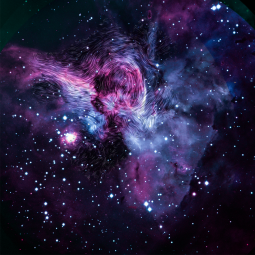By Youngmin Seo and Joan Schmelz
Paper:
Probing Polarization and the Role of Magnetic Fields in Cloud Destruction in the Keyhole Nebula
Seo, Young Min, et al., 2021/08, ApJ, 917, 57.
High-mass star formation is a fundamental process that drives the life cycle of the interstellar medium (ISM) and the evolution of galaxies. The majority of stars form within high-mass clusters, where stellar feedback generates turbulence and provides the energy to transform one phase of the ISM into another. Extreme star-forming regions that are well resolved provide unique analogs to the starburst period of galaxy evolution. Thus, probing the detailed processes within these regions in the Milky Way is crucial for understanding more generally how galaxies evolve.
The magnetic field is one of the crucial elements regulating physical processes in star-forming regions. It may regulate the star formation rate and efficiency by providing support against self-gravity in giant molecular clouds and cloud cores. Magnetic fields in cloud cores are inherited by protoplanetary disks and affect planet formation. Low-mass star-forming regions exhibit a clear trend where magnetic fields are parallel to the long axis in low-density filaments and perpendicular to the long axis in high-density filaments.
Observations to date show that magnetic fields in high-mass star-forming regions are typically ordered (perpendicular or parallel) to the morphologies of bright-rimmed clouds, bars, pillars, or cometary globules. They also show a more complex structure than those in low-mass star-forming regions, demonstrating that magnetic fields can be altered by the effect of stellar feedback. However, little is known about the role of magnetic fields in the evolution of molecular clouds and the life cycle of the ISM by stellar feedback.
The Carina Nebula complex, with its ~70 O-type stars, is the most energetic star-forming region in the Milky Way. The Keyhole Nebula is only 1.3 pc away from η Carinae and is one of the clouds most severely affected by outbursts and X-rays. It contains a loop structure, which may have been formed by the powerful outflows from η Carinae that deformed the cloud. It is an excellent testbed in which to study the role of magnetic fields in a cloud undergoing extreme stellar feedback.
HAWC+ provided a detailed polarization map of the dust continuum emission of the Keyhole Nebula. The observations reveal that the magnetic field orientation in the bar structure, which is not distorted by η Carinae, is almost identical to that of the large-scale magnetic field in the complex. On the other hand, the magnetic field in the loop is not correlated with the large-scale field structure. The orientation of the field in the region between the bar and the loop exhibits a fan shape that aligns with the direction of η Carinae's stellar wind. These features clearly demonstrate that the magnetic fields are disturbed by stellar feedback.
If magnetic fields are to regulate the cloud evolution against stellar feedback, the magnetic tension in the loop should be similar to the ram pressure of η Carinae's stellar wind. The polarization angle dispersion and the curvature of the loop seen using SOFIA show that the pressure exerted by the magnetic field tension in the loop is significantly weaker (~10 -3 ) than the ram pressure of η Carinae's stellar wind. These results imply that while magnetic fields dominate during star formation, they play only a minor role in the cloud evaporation and destruction processes governed by stellar feedback. It will be interesting to see if these results for the Keyhole Nebula apply to other high-mass star-forming regions.
